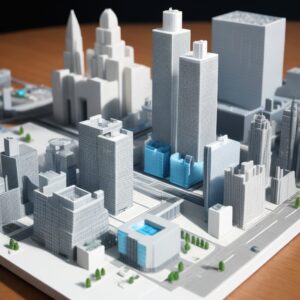The Foundations of 3D Printing in Urban Planning

3D printing takes conceptual sketches and digital renderings from the virtual into the tangible, providing urban planners and architects with a powerful tool for envisioning the future of cities. With the precision of 3D printing, urban models can be elaborated down to the minutest detail, from the texture of building facades to the landscaping of green spaces. This enables a examination and testing of urban designs against various scenarios, such as traffic flow, pedestrian movement, sun exposure, wind patterns, and more before any physical groundwork begins.
The ability to experiment with these models is transformative. Traffic congestion points can be identified and mitigated, public spaces can be optimized for human use, and infrastructural elements can be integrated into the urban landscape in the most effective and least obtrusive ways. These models become collaborative playgrounds, where interdisciplinary teams can come together to troubleshoot and refine ideas in a cost-effective and time-efficient manner.
The radical reimagining afforded by 3D printing in urban planning extends beyond these initial planning stages. The technology’s scalability is paving the way for the manufacturing of actual construction elements and, increasingly, entire buildings. This means urban planners are able to fabricate components optimized for sustainability, durability, and aesthetic appeal. Innovations such as 3D-printed solar panels can be integrated into designs from the get-go, streamlining the incorporation of renewable energy sources into new developments.
This technology democratizes the urban planning process, allowing for community involvement and feedback on a level not previously possible. Residents can experience potential changes to their environment first-hand and contribute to the planning dialogue, fostering a sense of ownership and civic engagement.
The foundations of 3D printing in urban planning are established on the capability to actually execute parts of the envisioned futures at various scales.
Redefining Construction – Faster, Stronger, Eco-friendlier
The advent of 3D printing techniques has indeed redefined the traditional construction paradigm with a compelling trifecta of speed, strength, and sustainability. This modern method of building presents the flexibility to fabricate components or structures with complex geometries that would otherwise be costly or impossible using conventional methods. The design freedom afforded by 3D printing encourages architectural creativity and engineering innovation, leading to the creation of structures with improved functionality and aesthetic appeal.
3D printing’s impact on environmental sustainability is important for urban development. As the construction industry is traditionally associated with high levels of material waste and carbon emissions, the precision of 3D printing in depositing exact quantities of material translates into a significant reduction in waste. This technology opens pathways for incorporating recycled materials into new construction, thereby promoting a circular economy where materials are reused rather than discarded. The result is a reduction in the environmental footprint of building projects, which aligns with increasingly stringent sustainability goals and regulations.
Further environmental benefits emerge when considering the potential improvements to building performance. With 3D printing, architects and engineers can design and produce intricate wall structures and building envelopes that optimize insulation and natural ventilation. These advancements can contribute to the creation of energy-efficient buildings that require less heating and cooling, lowering energy consumption and associated greenhouse gas emissions over the lifespan of the structure.
Customization as The New Standard
The traditional approach to urban infrastructure often relies on mass-produced, standardized elements that may not fit the specific character or demands of a given community. This can leave public spaces feeling impersonal and disconnected from the cultural and social fabric of the area. By leveraging 3D printing, urban planners and designers can break free from these constraints, offering tailor-made solutions that cater to the unique identity and requirements of different neighborhoods.
Customization through 3D printing means that every element of urban design can be thoughtfully created to address local challenges and embrace community features. Benches, lighting, park fixtures, and even waste receptacles can be thoughtfully designed to serve their practical purpose and enhance the aesthetics and functionality of the space. This localized approach empowers communities to reflect their heritage, values, and aspirations in their public spaces, ensuring that the built environment resonates with the people who use it daily.
Such customization facilitates inclusion and accessibility. Urban elements can be printed to accommodate the needs of different individuals, such as incorporating Braille for the visually impaired or designing comfortable seating for the elderly. This focus on personalization could lead to urban spaces that are more inclusive and inviting to all members of society.
Public consultations, workshops, and forums can collect input from residents, which can then be translated into 3D designs that are as distinctive as the feedback they’re based on. Such active community participation enlivens the design process and fosters a deeper connection between the urban space and its users.
The trend of customization could transform public expectations regarding urban development. As communities become more engaged and witness the direct translation of their input into tangible outcomes, the demand for personalized, adaptable urban environments is likely to grow. The future of urban planning, powered by 3D printing, will be characterized by a greater diversity of forms and functions, reflecting the rich tapestry of urban life and creating spaces that people truly feel are their own. This new standard of customization promises to yield more lively, engaging, and adaptable urban environments that authentically reflect the dynamic spirit of their inhabitants.

